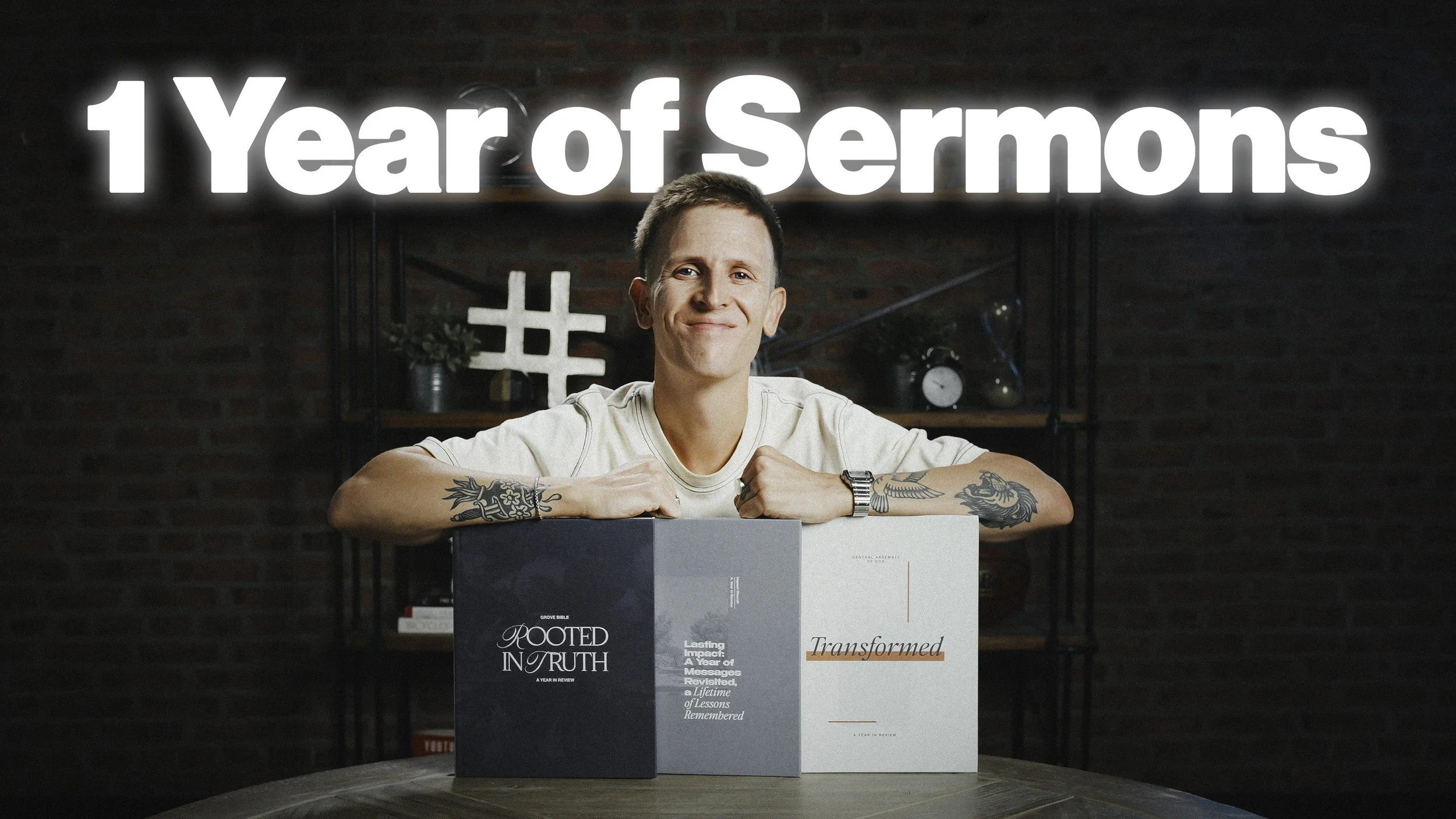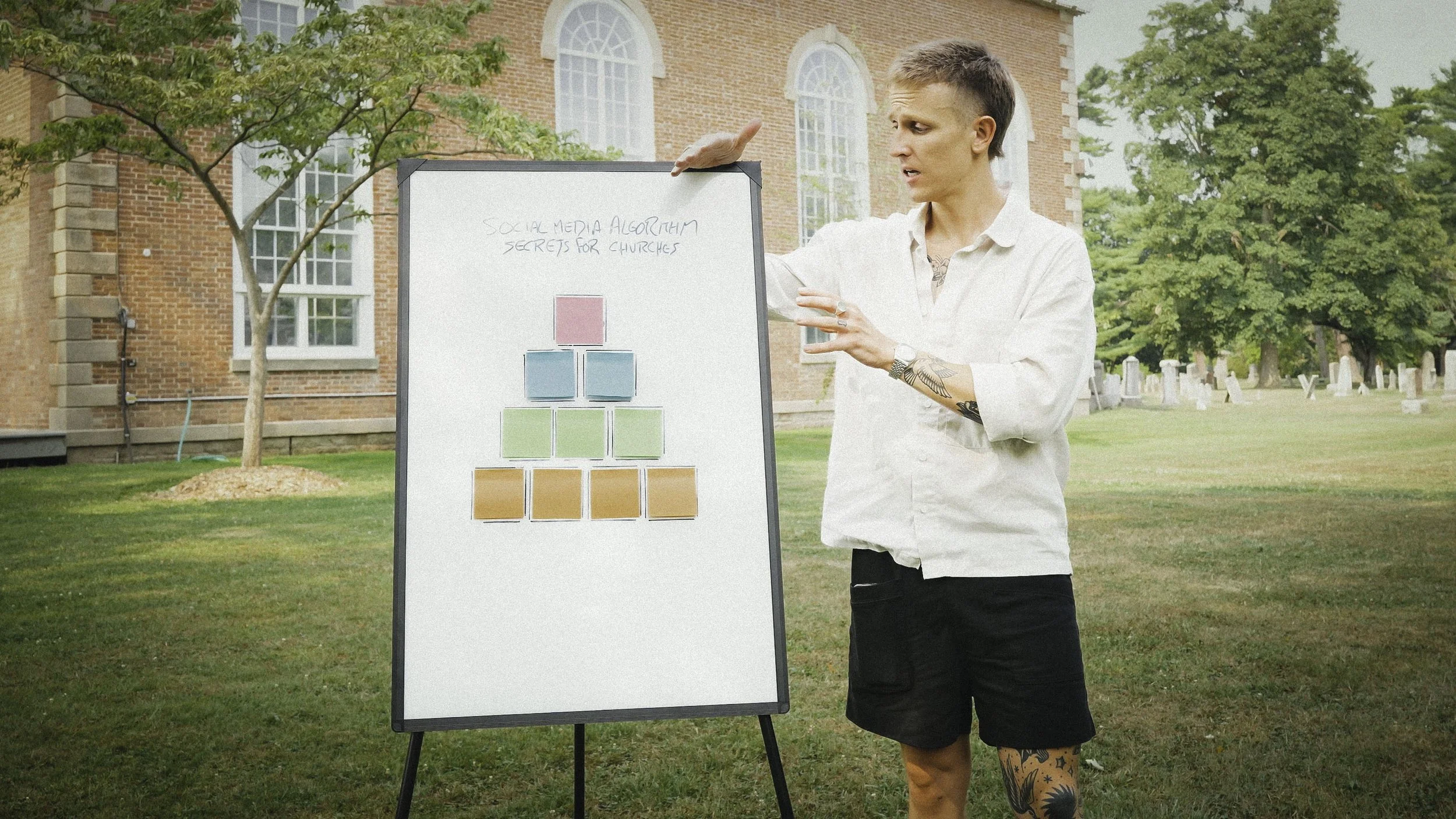The 1-Page Church Social Media Calendar
Welcome to my step-by-step guide on converting a single sermon into a diverse array of social media content.
That means vertical videos, quote posts, carousel posts, text threads, YouTube videos, blog posts, and even full-length books!
And we'll cover every major social platform.
All the best tips and tricks in this blog are also packaged into a 1-page download (link below) - so keep reading to learn how to apply this to your church.
Free Bonus
The 1-Page Church Social Media Calendar: My detailed process for taking one sermon and turning it into a week’s worth of social media content for your church.

Ready to get started?
Step 1: Start with a Full Sermon Review
The key is in the details. I begin by watching the entire sermon in its entirety. No bots, no AI.
Trust me. I have experimented with those tools extensively. I wanted them to work. I really did. Because they promised to be huge time savers, but they were all so bad.
There's so much we can use AI for (which we'll get to later), but the quality of the social media content we'll create here is 100% dependent on your review of the sermon.
The whole process hinges on this part.
So what am I looking for?
I’m searching for standout sections that reside at the intersection of faith and culture and are ideally emotional, relatable, or controversial.
Now, hear me when I say controversial; I don't mean sensational without substance. I don't mean outrage-bait. And I definitely don't mean anything disingenuous.
Here's a great example - a post titled, 'Why Your Spouse Matters More Than Your Kids.'
That's a pretty common teaching in many churches. But, outside the church? Not so much.
The reality that the ways of Jesus are very counter-cultural played a big role in this post, reaching a broad audience.
Key Takeaway #1: Searching for sections that resonate at the intersection of faith and culture and are emotional, relatable, or even controversial (in a meaningful way) proves effective in reaching a wider audience.
Step 2: The Core Components
I mark five specific segments during the review:
Three Short Sections (60-90 seconds each): Two vertical videos and one carousel.
One Powerful Quote: Short and impactful.
One Longer Segment (6-20 minutes): Ideal for a full-length YouTube video.
Once I've found those timestamps, I start working on the vertical videos first.
Step 3: Creating Vertical Videos
The main challenge I need to solve out of the gate is contextualizing these sermon clips for the social media audience.
I've seen the whole sermon.
They haven't.
They're missing 20, 30, or 40+ minutes of additional material.
So, what’s the secret?
Write a hook and inject it into the video's first three seconds.
I incorporate a compelling hook in the first three seconds, ensuring it's a cliffhanger, common, and something people care about.
*Remember to avoid covering on-screen elements with captions or graphics – keep them in the safe zone.
The Art of Writing Hooks
Writing a good hook comes down to The 3 C's: cliffhanger, common, and care.
When I write a hook, I give each of those three categories a score out of 5. Hooks should score more than 10 out of 15 across The 3 C's. Otherwise, the hook I've written will not stop a person's scrolling on social media.
The first C is cliffhanger: What's the mystery I'm creating here?
Well, take a look at this hook: "The #1 Job Of A Parent." That's an unfinished loop.
I could have written this hook as "Why It's The Parent's Job To Bring Their Children To Jesus."
That's accurate and faithful to the subject matter, but that hook already reveals the thesis.
No good.
The second C is common: Is this content something people can relate to?
Parenting content will always excel here because it's the kind of subject matter that aligns with Scripture and the missional emphasis of most churches…
But it's also something our culture desperately needs.
There's that intersection of faith and culture that we're looking for.
Finally, the third C is care: Will the viewer care about what you're talking about?
I always like to use gratitude as my example here because we can all agree practicing gratitude is healthy, rooted in Scripture, and something we could all do a little more of.
But when I wake up in the morning thinking about my work, my kids, the finances, and my marriage, practicing gratitude isn't top of mind.
It doesn't mean we can't bring people to that place, but we don't want to start there because that's not where their attention is.
Their attention is on their kids, though.
Here are three more tips on these vertical videos:
#1. Keep captions clear of on-screen elements.
I see churches mess this up all the time.
In my video editing software, I have a layer on my timeline with an overlay that guides me to ensure I stay in the safe zone.
When you don’t take time to think about this, your captions often get cut off by the “Like button,” and it looks sloppy and makes the captions challenging to read.
#2. Emphasize important parts twice for better retention.
When compiling your video, it's okay and even recommended to emphasize the same part twice.
One of my key strategies involves replaying the video segment that initially appears in the hook at the beginning, again later in the video.
At the beginning of the clip, the pastor says: "This is the primary role for us as parents."
This same clip reappears later in the video at the 18-second mark.
The emphasis helps the message sink in better.
And even more practically…
Since this phrase initially appears at the start of the video, along with the text of the on-screen hook and before the captions appear, viewers scrolling on silent mode might miss it.
Therefore, repeating this segment later in the video ensures viewers have a second opportunity to catch it, even if they missed it initially.
#3. Use tools like Remini to enhance image quality.
When dealing with sermon videos, the footage resolution is sometimes…not so great.
So when creating covers, I'll grab a still and upload it to an AI tool called Remini.
Here's where AI can be helpful.
It will upscale the image and clean it up, which leads to a much sharper and higher-quality cover for the thumbnail and grid.
There you have it: the process I use for creating two vertical videos for the week.
They'll get published on Tuesday and Thursday to Instagram Reels, Facebook Reels, TikTok, YouTube Shorts, and X.
That's ten posts across five social platforms already.
Next up…
Step #4: Quote Posts and Carousels
It's straightforward, mainly.
As I'm listening through the sermon, I'm always waiting for those pithy one-liners that pastors often go to. The quote post is the easiest post to compile in the week. (typically)
So if you want to do this first, that's cool.
What to look for in a quote:
You want the quote to be snappy.
Short- Under 100 characters.
And again, emotional, relatable, or controversial is what you're looking for.
Here's an example: "Christians have no business in judging the behavior of unbelievers."
That's awesome.
We'll post this on Monday, published as an image to Facebook and Instagram, and as text-only to X.
Next, we will take that third 60-90-second segment we identified, extract the transcription, and use this to make our carousel.
How you go about this is really up to you. If you're an experienced writer, you may want to prepare the carousel yourself using the transcription you've generated.
You may also explore an AI tool that rewrites or rephrases content. This is one of the ways I believe churches can ethically use AI tools.
You have the source material already. You're not asking the AI to come up with anything. You're simply having it polish up the prose.
As for the design with carousels- we have seen the best performance when there’s minimal design. Just put a big, bold headline on the cover, then smaller text in the remaining slides.
Here's an example of what I came up with.
We'll publish the carousel to Instagram on Wednesday. The downside of carousels is that you can only post them to Instagram.
To fix this, we will take the cover image only and publish that to Facebook and X and use the copy from the entire carousel to create a text thread.
Voila.
If you recall, I marked off five sets of timestamps in my sermon review.
We've used two shorter segments for our vertical videos.
One quote.
One shorter segment for our carousel.
This leaves us with our longer 6-20 minute section that will power our YouTube video and our blog post.
We'll start with YouTube.
Step #5: Crafting YouTube Videos
YouTube is the second-largest search engine in the world. The average length of a first-page YouTube video is 14 minutes, 50 seconds.
Your superpower:
Your church has video content already filmed, which is perfect for YouTube.
Your kryptonite:
It's too long
And the title is not optimized for search.
It might be getting tucked away in the Live tab, not even visible on your channel at first glance.
It doesn't have a compelling intro
And it's almost certainly lacking an eye-grabbing thumbnail.
The content is there, though! We just need to prepare it.
During your sermon review, the idea here is to identify a segment of the overall message that can stand on its own.
Commonly, a preacher's sermon will have three points. Each of those points often makes for a great standalone video.
For example…
The sermon video we're starting with is titled "Conversation Starter: Foot Washing - September 3rd, 2023."
Typical YouTube post for a church.
This content will be lost to the archives if we just leave it like this.
So let's not.
Instead, we’re going to do these things:
Correct length of the video
Use an eye-grabbing thumbnail
Add a title optimized for search that takes the truth of Scripture and makes it accessible to all people.
Let's watch the first 30 seconds or so of the video together.
Here are a few important notes for you:
Enhance the video with captivating intros, captions, and an engaging thumbnail.
> The captions are crucial because YouTube videos autoplay when you hover over the thumbnails on a desktop.
This allows users to preview videos without sound before committing to them.
We need captions and an engaging opening to hook those viewers.
> Add background tracks to the opening segment.
When searching for audio for this purpose, I often use the keyword 'suspenseful' because I want the track to have an unfinished feeling.
> And then, finally, when we transition to the full sermon clip, I'll put a lower third on the screen with the church's name, the pastor's name, and the video's title.
Because when people come from a search, they don't know who this person is or where they're from, so we need to introduce ourselves.
We'll package that video up for YouTube, linking to the full service and message in the description, and that'll go live on Friday.
Now, at this point, we've got content from Monday through Friday.
The easiest post to create, the quote, is on Monday. The most involved post to create, the YouTube video, is on Friday.
So, you could go through this entire process starting on Sunday, the day the sermon was preached, and have it all done before the week is out.
But I don’t personally recommend that and here’s why.
There's really nothing to gain by publishing all that content before next Sunday. If anything, it'll just burn you out and make it more likely you can't keep this up.
So, I suggest being on a week’s delay. I've got a whole Instagram post dedicated to this if you want to learn more.
Believe it or not, though, we're still going. And this section is really only for the real sickos.
Because what I'll also do now is take that YouTube video transcription and turn it into an entire blog post like you’re reading right now.
Here’s how I tweak it for a blog:
Add a title optimized for search
Format with headings, relevant hyperlinks, appropriate line breaks, bold, italics, etc.
Embed the YouTube video we just published into the blog post itself
Use the thumbnail for the featured image
Then, I publish it to my church's website on Saturday.
Now, we've got an article that can rank in search engines and bolster our church's SEO presence, but more importantly, we've extracted a teaching from our pastor that can be used down the road practically.
Imagine someone coming to church dealing with, in this case, betrayal, and someone in leadership meets with them for pastoral care.
They can print out this article and give it to the person at the end of the session. Now, they've got something to revisit later on in the week.
They've got a helpful reminder, rich in Biblical encouragement, from their faith community.
That’s incredible!
Follow this process every week, and you'll have 52 written articles capturing the journey your church has been on over the last year.
And this is just because I love you all so much:
The final act is to compile those articles into an actual book.
I like to design it like a coffee table book with a beautiful cover and layout of pages, so it's a standalone art piece.
You can sell these in your church to recoup the printing costs. You can give them away.
Either way, they make for powerful and beautiful embodiments of your church family's journey over the previous twelve months.
Wrapping Up
And that's how you go from one sermon to a complete social media calendar. That covers every social platform.
And every content format from long-form text, to carousels, to quotes, to stills, to short-form and long-form videos - it's all here.
I've refined this process by working with churches 1-on-1 at SocialSermons.com.
If you want to work with me directly, we'll do everything for you, so you never have to lift a finger.
We only have capacity for 150 churches. And we sold out those spots in the first week we launched.
But you can join the waiting list on SocialSermons.com.
That being said, if you do see the 'Book A Call' option on the site, that likely means we have a few spots available.
I keep 2-3 spots open as much as we can.
If you think you'd be a good fit, you can book a call with me directly, and we can see if we're a good match for each other.
At the top of the SocialSermons homepage, you'll also find a tab called Recent Work.
All the examples we discussed in this blog are there so that you can see them in greater detail.
Conclusion
Finally, remember to download the 1-page cheat sheet covering all these strategies.
Thanks for your time, attention, and trust. Together, we’re making church communication better.
Looking forward to our next conversation!
Free Bonus
The 1-Page Church Social Media Calendar: My detailed process for taking one sermon and turning it into a week’s worth of social media content for your church.















